Software Design¶
- Table of contents
- Software Design
System behavior is controlled by the MCU integrated in the motherboard, which communicates with other subsystems through the Cubesat Kit Bus. The MCU is programmed in C language based on the RTOS Salvos. Therefore, the stack implementation is programmed under these constraints.
The complete set of source and object files of the project can be found from Cubesat source files
Communication stack¶
Figure below presents the final implemented communication stack of the system as part of the communication chain design.
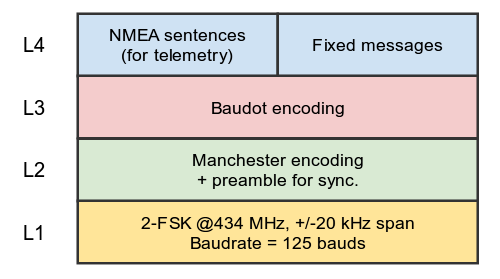
Communication stack.
L4, L3 and L1 are determined from mission objectives and technical requirements (i.e. the goal of the mission is to send telemetry data in RTTY format using a 2-FSK modulation). However, L2, which is a Manchester digital modulation, is introduced in the stack in order to overcome a limitation of the RF transmitter.
This transmitter is not suited to low bit rates because of the internal power management. Since it does not have any ENABLE pin, it handles the power consumption shutting down the module after 9.8 msec. (measured at the laboratory) having a digital 0 at the input. So, this limits the maximum pulse width that can be sent.
Manchester encoding ensures one transition per each bit, therefore lower bit rates can be reached.
| Data format | Min. bit rate w/Manchester | Min. bit rate w/no Manchester |
|---|---|---|
| ASCII, USART: 8 bits + no parity | 103 bps | 918 bps |
| Baudot 1+5+1 | 103 bps | 612 bps |
NMEA sentences¶
The National Marine Electronics Association (NMEA) has defined a standard intended to allow marine electronics to send navigation information to computers and to other marine equipment. Most GPS receivers communicate with other devices using this specification. Thus, most computer programs and applications which provide real time position information understand and expect data to be under NMEA specifications.
NMEA0183 is provided as a series of comma-delimited ASCII strings, each preceded with an identifying header. This set of strings are usually sent through a serial bus, which lets any microcontroller with a USART port extract data from and communicate to a GPS receiver module.
Each line of data is a sentence that is totally self contained and independent from other sentences. Each sentence begins with a '$' and ends with a carriage return/line feed sequence and can be no longer than 80 characters.
Inside a sentence, data fields are separated by commas. There is a provision for a checksum at the end of each sentence which may be used to verify the data integrity. The checksum field consists of a '*' and two hex digits representing an 8 bit exclusive OR of all characters between, but not including, the '$' and '*'.
There are standard sentences for each device category. For instance, for GPS receivers the prefix is GP.Some standardized "sentences" from GPS devices are:
- $GPGGA,170834,4124.8963,N,08151.6838,W,1,05,1.5,280.2,M,-34.0,M,,,*75
- $GPGSA,A,3,19,28,14,18,27,22,31,39,,,,,1.7,1.0,1.3*34
- $GPGSV,3,2,11,14,25,170,00,16,57,208,39,18,67,296,40,19,40,246,00*74
- $GPRMC,220516,A,5133.82,N,00042.24,W,173.8,231.8,130694,004.2,W*70
The most important NMEA sentences include the GGA which provides the current Fix data, the RMC which provides the minimum gps sentences information, and the GSA which provides the Satellite status data.
Details of a GGA NMEA sentence¶
GGA sentences carry essential fix data which provide 3D location and accuracy data.
Example: $GPGGA,123519,4807.038,N,01131.000,E,1,08,0.9,545.4,M,46.9,M,,*47
| Field value | Data |
|---|---|
| GGA | Global Positioning System Fix Data |
| 123519 | Fix taken at 12:35:19 UTC |
| 4807.038,N | Latitude 48 deg 07.038' N |
| 01131.000,E | Longitude 11 deg 31.000' E |
| 1 | Fix quality: 0 = invalid 1 = GPS fix (SPS) 2 = DGPS fix 3 = PPS fix 4 = Real Time Kinematic 5 = Float RTK 6 = estimated (dead reckoning) (2.3 feature) 7 = Manual input mode 8 = Simulation mode |
| 08 | Number of satellites being tracked |
| 0.9 | Horizontal dilution of position |
| 545.4,M | Altitude, Meters, above mean sea level |
| 46.9,M | Height of geoid (mean sea level) above WGS84 ellipsoid |
| (empty field) | time in seconds since last DGPS update |
| (empty field) | DGPS station ID number |
| *47 | the checksum data, always begins with * |
Manchester encoding¶
In telecommunication, Manchester coding assigns for each data bit one transition and both states last the same time. Since there is at least one transition per bit, this allows the signal to be self-clocking, and the receiver to synchronize itself with the sender clock. The main drawback is that Manchester encoding requires the double of the bandwidth compared to a simple unipolar coding scheme.
There are two opposing conventions for the representations of data. The first of these was first published by G. E. Thomas and is followed by numerous authors. It specifies that for a 0 bit the signal levels will be low-high, with a low level in the first half of the bit period, and a high level in the second half. For a 1 bit the signal levels will be high-low.
The second convention is followed by numerous authors as well as by lower speed versions of IEEE 802.3 (Ethernet) standards. It states that a logic 0 is represented by a high-low signal sequence and a logic 1 is represented by a low-high signal sequence.
Let x(t) be the unmodulated binary signal, y(t) the modulated binary signal and ck(t) the clock signal. Where the clock signal is a square wave signal with duty cycle of 50%. If Rb is the bitrate for x(t), then the bit period is Tb=1/Rb.
Thus, Manchester (Thomas convention) defines:
y(t)=x(t) xor ( not ck(t))
In the same way, Manchester (IEEE convention) defines:
y(t)=x(t) xor ck(t)
- If x(t)=0, for t0<t<t0+Tb, then
- y(t)=0, for t0<t<t0+Tb/2
- y(t)=1, for t0+Tb/2<t<t0+Tb
- If x(t)=1, for t0<t<t0+Tb, then
- y(t)=1, for t0<t<t0+Tb/2
- y(t)=0, for t0+Tb/2<t<t0+Tb

Manchester encoding [3].
Overall program description¶
The Salvo OS is a multitask operating system, based on the definition of multiple tasks. Each task is implemented inside an infinite loop.
The system main program is composed by two tasks. One in charge of L2+L1, controlling the physical layer and the other one in charge of acquiring plus filtering data from the GPS module, and formatting it (L4). In addition, a specific function is in charge of mapping the native ASCII messages coming from L4, into Baudot alphabet (L3) to be sent to L2+L1.
Tasks, functions and main data structures description¶
Task and functions:- task_gps_update(): task which performs data acquisition and filtering from GPS module.
- task_rtty_phy(): task which modulates the signal which controls the RF module.
- baud_coding(): function which performs the mapping from the ASCII buffer to the Baudot buffer.
- baudTranslate(): function which perform character translation based on a lookup table.
- inc_pointer(): function which handles the dual-pointer in charge of pointing the bit to be sent from the Baudot buffer.
- asciiCharBuf[RTTY_BUFFER_SIZE]: stores data at L4 to be sent to lower layers.
- rtty_buffer[2*RTTY_BUFFER_SIZE]: stores data at L3 which is the data coming from L4 mapped into Baudot alphabet.
- rts_flag: flag which controls the behavior of the task task_rtty_phy(). When it is set, data stored in rtty_buffer is modulated and sent to the physical layer L1. When it is not, an IDLE state signal is sent to L1.
- cod_flag: flag which controls the behavior of the task task_gps_update(). When it is set, data comming from GPS module is processed and filtered. When it is not, there is no processing and characters are discarded.
Program workflow¶
Data coming from GPS is retrieved from the USART CSK_0 register. Since data is continuously sent character by character at a rate of 1 NMEA sentence per second, the task_gps_update() has to filter the incoming characters waiting the right sequence which represents the start of a valid NMEA sentence. Then, characters must be stored in a buffer until the reception of the end of sentence indicator. The string stored in the ASCII buffer (asciiCharBuf) is the message that has to be sent later to the lower layers, representing the information held by the beacon. Optionally, an additional fixed messaged can be added to this buffer.
Once beacon message is defined, the task call the function baud_coding(), which maps the stored chars in the ASCII buffer to the Baudot alphabet. Finally, the output (the message in Baudot format) is stored in another buffer (rtty_buffer). This function, is supported by another one, baudTranslate(), which is called to perform a search and translation of symbols for each character using a look-up table.
Once data in the Baudot buffer is completed, a ready to send flag (rts_flag) is set to indicate the task which manage L2-L1 that there is data available ready to be sent.
task_rtty_phy() is in charge of controlling lower layers and generate the output signal (at IO.0) which controls the 2-FSK transmitter. This task runs continuously and has the highest priority. Since a clock is required to generate the output signal, the task uses the OS timer. This timer is set to one tick per millisecond, this is 1000 ticks per second. Since required baudrate is 125, the bit period Tb is 8 msec and the task uses 8 OS ticks per bit.
Each bit period Tb, the task performs an iteration and retrieves the bit to be sent at L3. Then it implements Manchester by setting the output signal at 0 (or 1) during Tb/2 and then switching to 1 (or 0) during other Tb/2.
The figure below shows the state machines which models the behavior of the main program.
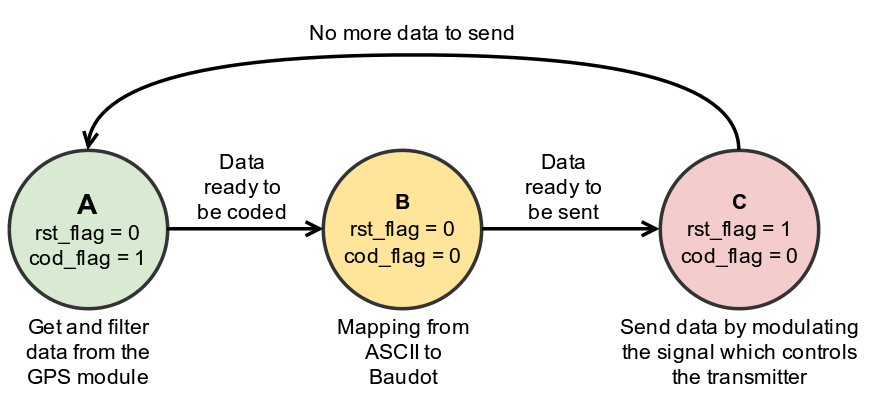
Main program states machine.
Task task_gps_update()¶
The task is active when the program is in states A or B, this is when task_rtty_phy() is in IDLE (rts_flag is not set).
When cod_flag is set, the task performs data acquisition from the GPS module. Once the sequence of characters "$GP" has been detected, the incoming data is stored in the ASCII buffer (asciiCharBuf) up to receive the character which indicates the end of the sentence ('\n'). The sequence detection is implemented as a states machine, shown in the figure below.
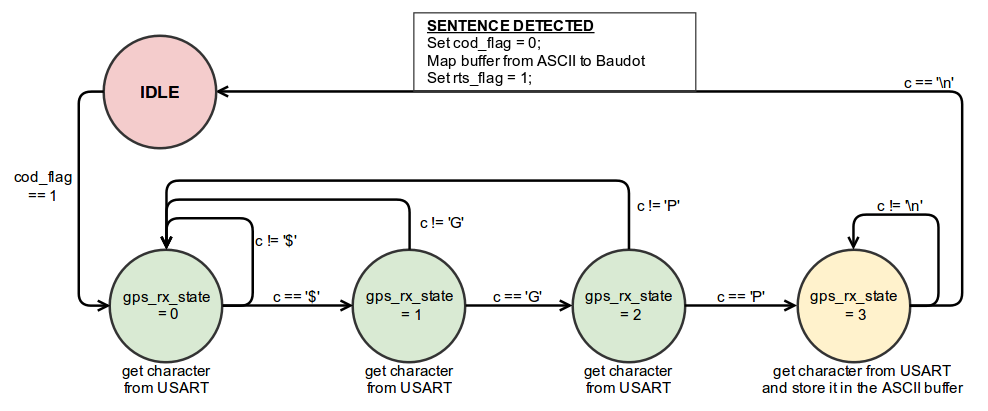
States machine of the GPS module communication task.
The task uses static variables to store the state of the sequence detector and the pointer which indicates where the incoming data must be stored inside the ASCII buffer.
As explained before, once data in the ASCII buffer is defined and ready to be processed, the task indicates that acquisition is finished by setting cod_flag to 0. Therefore, the main program goes to state B, in which the task does not perform acquisition while cod_flag is kept at 0.
In the next iteration the task calls baudTranslate() to map the data into Baudot and then, when mapping is finished, signals to the task task_rtty_phy() that there is data ready to be sent in the Baudot buffer by setting rts_flag to 0. Thus, the main program goes to state C.
While rts_flag is equal to 0, the task is inactive and discards characters coming from the GPS module in order to keep the USART register empty.
At the end of each task iteration, the task calls the Salvo OS macro OS_Yield() which performs context switching, letting the task scheduler to pass the control of the processor to another task.
A flowchart representing the task behavior is shown below.
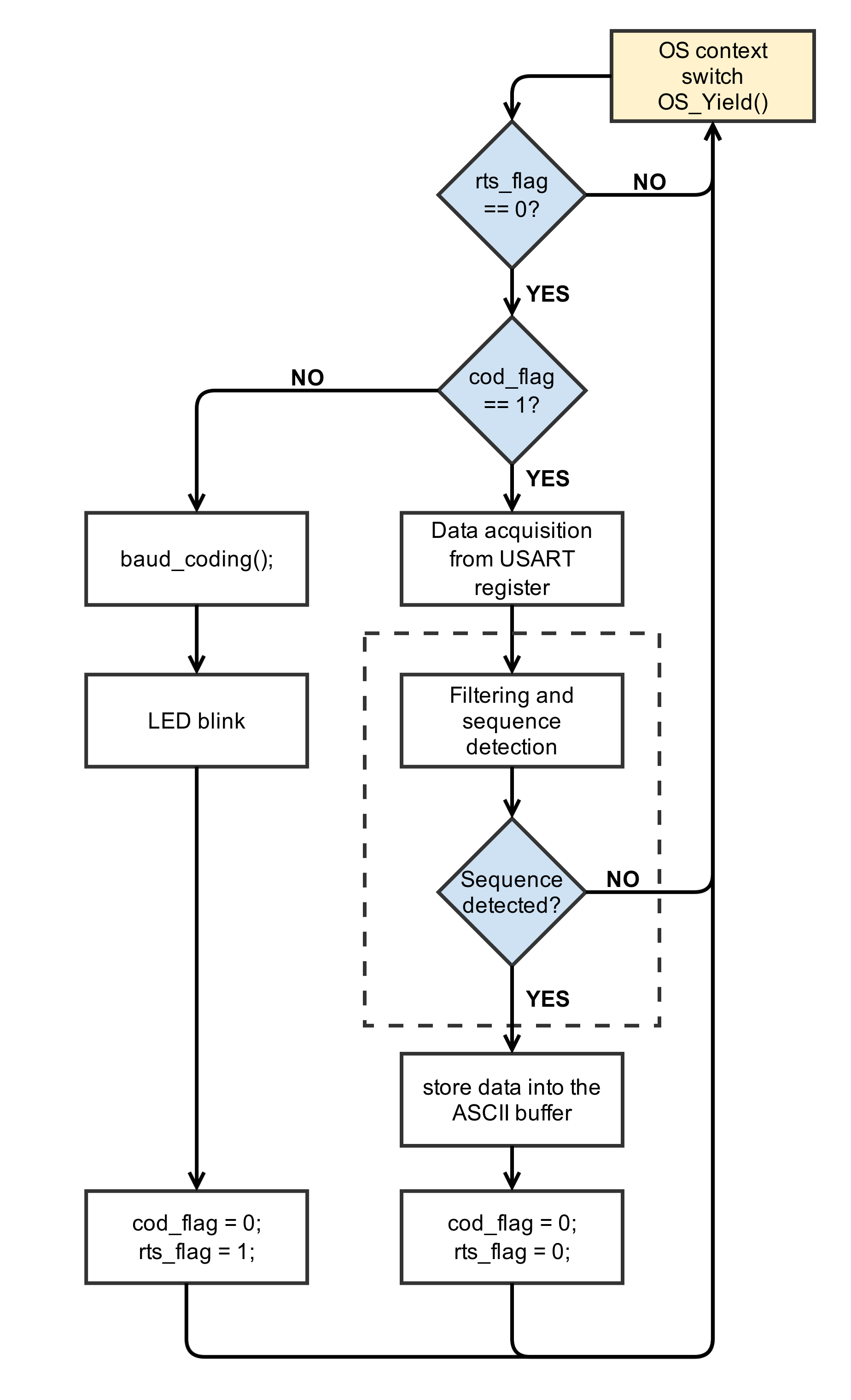
Flowchart of the task "task_gps_update()".
Task task_rtty_phy()¶
The task performs a complete iteration each Tb, defined as 8 OS ticks, since OS Timer is defined to provide 1 OS tick per each millisecond.
While rts_flag is set to 1, the task retrieves a bit from asciiCharBuf for each iteration. The bit is obtained by using a dual-pointer. Firstly, the byte pointed by the "word pointer" is read and then a shifted mask is applied. The mask shift is defined depending on the value of the "bit pointer". The value of the bit is stored in the variable rtty_out which is the image of the output at L3 level. When rts_flag is set to 1, there is no bit reading operation and the output image is set to IDLE value.
After the value of the image is defined, the output port is binary modulated according to the Manchester encoding (L2). This is implemented by, first, setting the corresponding value of the output port, then calling OS_Delay(Tb/2), then switching the output port value and finally calling again OS_Delay(Tb/2).
Each call to the Salvo OS macro OS_Delay(), there is a context switch, giving the task scheduler the control of the processor to pass it to other eligible tasks. Therefore, since task_rtty_phy() has the highest priority, all other processing activities (from other task and functions) are done during these periods of time.
In addition, when the task state changes from inactive to active (rts_flag changes from 0 to 1), before sending the first bit, a synchronization sequence is sent to the output port. This sync. sequence is a high level signal (output set to 1) pulse which lasts 7Tb, (i.e. transmission duration of a complete Baudot word, composed bit 1 start bit + 5 symbol bits + 1 stop bit). This synchronization sequence is used to help the receptor to find the proper sampling time.
A flowchart representing the task behavior is shown below.
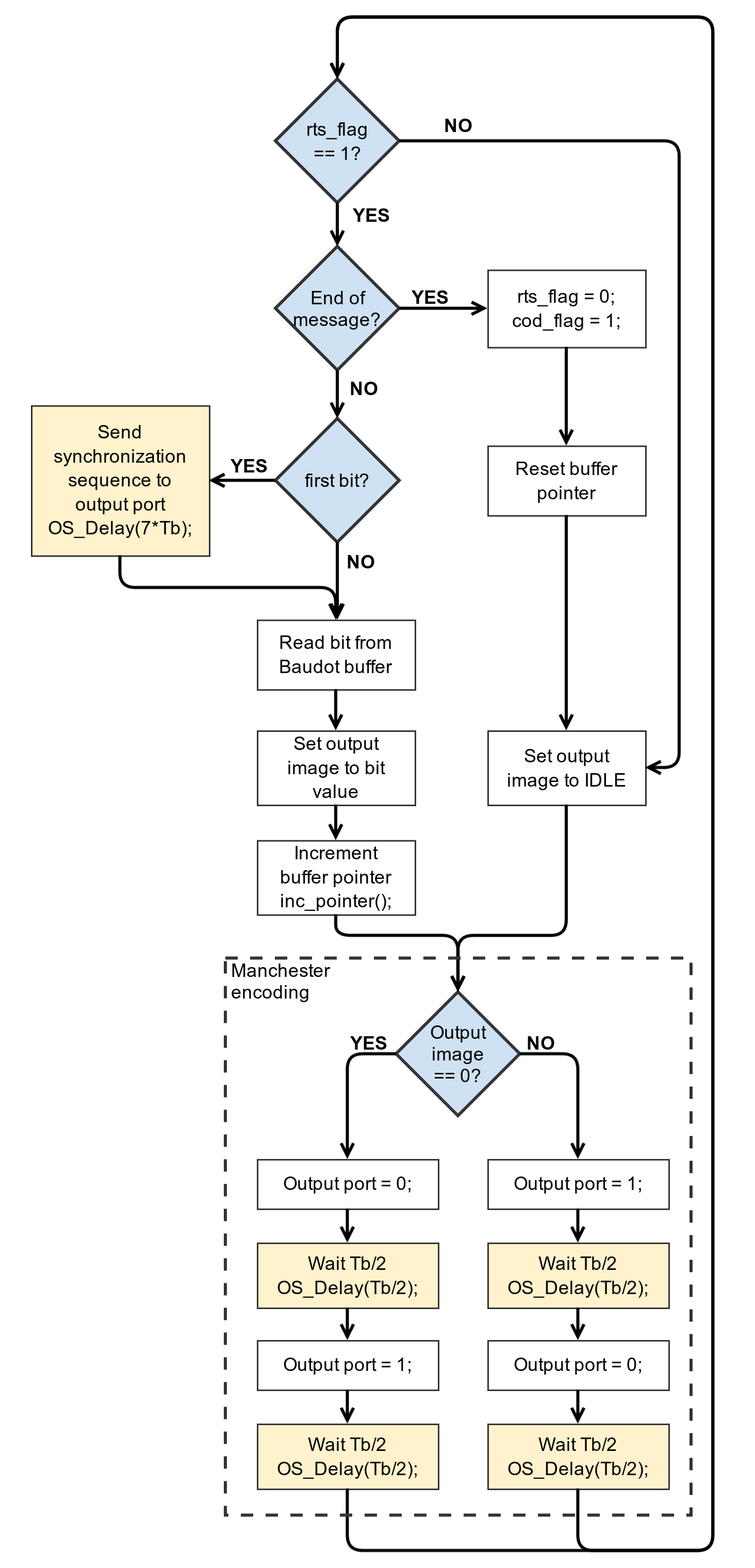
Flowchart of the task "task_rtty_phy()".
Function baud_coding()¶
This function sweeps the ASCII buffer (asciiCharBuf). It uses a local variable to store the actual mode (letter or figure). For each character, it calls baudTranslate() in order to compore both Baudot tables (figures and letters) and get the Baudot representation of the character. Depending on where a match is found, if the mode of the character is different from current mode, a symbol of mode shift is added before the character representation.
Finally, when asciiCharBuf is totally swept, the rtty_buffer contains the equivalent Baudot message.
Function baudTranslate()¶
This function searches either in the figure or letter tables, of the Baudot alphabet, if there is match between the input character and any symbol in the specified table. Then, the function returns the equivalent Baudot symbol of the match. If there is no matching, then the function returns the code BAUD_NULL in order to indicate that situation.
Function inc_pointer()¶
The task task_rtty_phy() uses a dual-pointer to retrieve the bit to be sent from the Baudot buffer. it is composed by a pointer to indicate the byte and other to indicate the bit inside the byte. For each iteration of the task, the dual-pointer must be incremented to the next bit. Therefore, the function inc_pointer() computes the right values of each pointer for the next iteration of the task.
References¶
[1] http://www.gpsinformation.org
[2] Parallax #28146 GPS Receiver Datasheet (GPS_Parallax_ManualV2.0.pdf)
[3] https://en.wikipedia.org/wiki/Manchester_code
